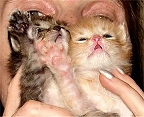Virginia Opossums (Didelphis virginiana) inhabit the United States east of the Rocky Mountains, Central America, and Pacific coastal North America. The Virginia Opossum is the only marsupial found in the North America. In South America and Australia there are about 80 species of Opossums. Opossums lived during the era of dinosaurs - fossil remains have been found from 70 million years ago.
Opossums - Taxonomy
- Class: mammalia
- Order: didelphimorphia
- Suborder: marsupials
- Family: didelphinae (Opossum)
- Genus: didelphis
- Species: didelphis virginiana.
Opossums - Reproduction
The breeding season for Opossums begins in December and may continue through October with most of the infants born between February and June. Like all marsupials, Opossum females have a well-developed pouch. They produce an average of 7 young, once or twice a year (litters of 17 kids have been reported). At birth, the infants are hairless, embryonic-looking, and weigh about 0.1 grams because the period of gestation is 12-13 days and because they are born at a very early stage in their development.Young Opossums have to make a long and difficult journey from the birth canal into the pouch and latch onto a teat. The mother helps by licking the hair leading into the pouch. There are only 13 teats in the pouch and not all may be functional, so the excess infants will not survive. The young open the eyes at around 60-70 days and are weaned at about 100 days of age. Then they are often carried as they cling onto the mother's back. After separation from the mother, littermates may share common dens for some time. Very few young Opossums survive to become adults.

